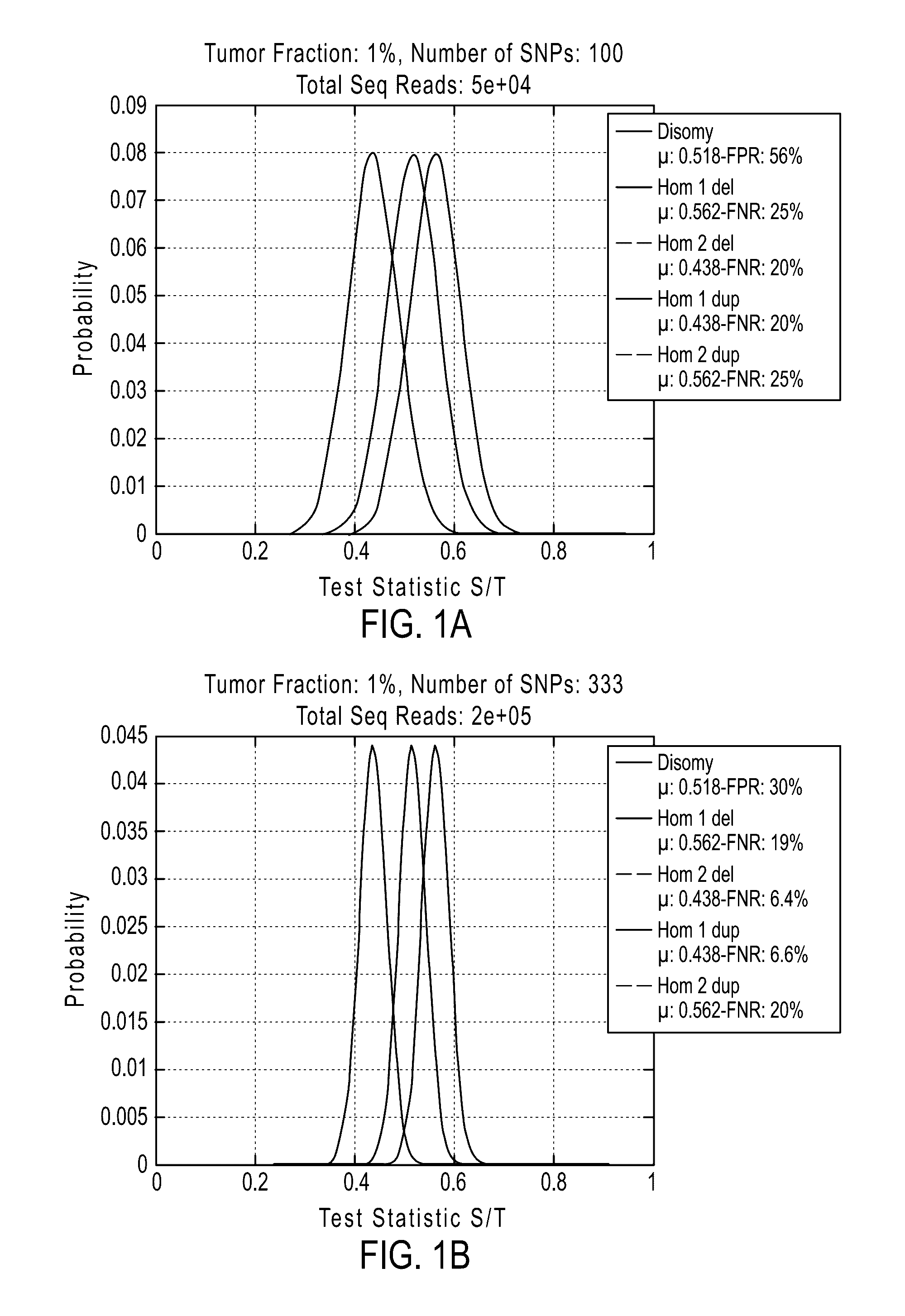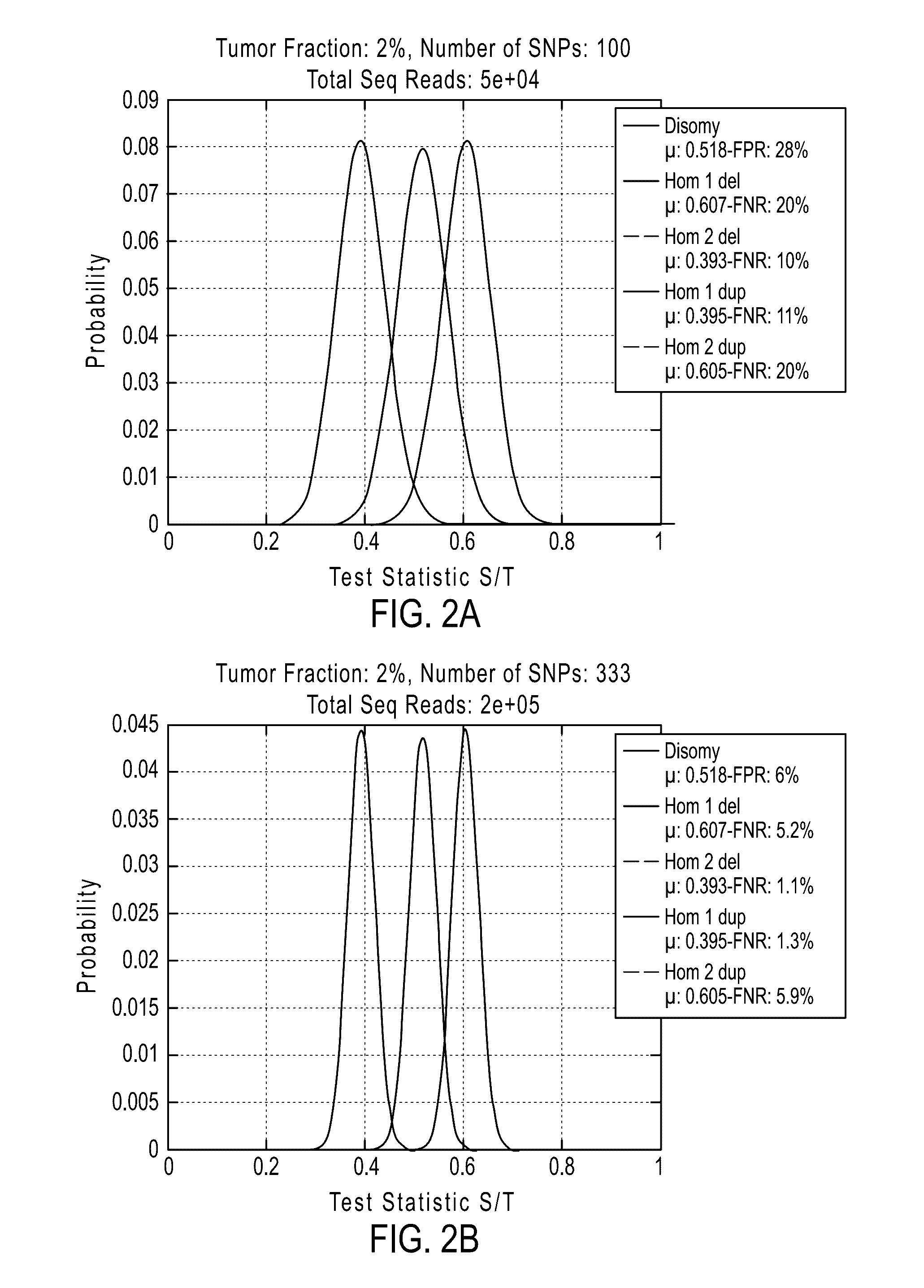Detecting cancer mutations and aneuploidy in chromosomal segments
a chromosome segment and cancer mutation technology, applied in the field of methods and systems for detecting ploidy of chromosome segments, can solve the problems of increased risk of infection, hair loss, ulcers in mucous membranes, and difficulty in detection, and achieves low copy number, low susceptibility to hiv infection, and high copy number
- Summary
- Abstract
- Description
- Claims
- Application Information
AI Technical Summary
Benefits of technology
Problems solved by technology
Method used
Image
Examples
example 1
[0844]Exemplary sample preparation and amplification methods are described in U.S. application Ser. No. 13 / 683,604, filed Nov. 21, 2012; U.S. Publication No. 2013 / 0123120, and U.S. Ser. No. 61 / 994,791, filed May 16, 2014, which is hereby incorporated by reference in its entirety. These methods can be used for analysis of any of the samples disclosed herein.
[0845]In one experiment, plasma samples were prepared and amplified using a hemi-nested 19,488-plex protocol. The samples were prepared in the following way: up to 20 mL of blood were centrifuged to isolate the buffy coat and the plasma. The genomic DNA in the blood sample was prepared from the buffy coat. Genomic DNA can also be prepared from a saliva sample. Cell-free DNA in the plasma was isolated using the QIAGEN CIRCULATING NUCLEIC ACID kit and eluted in 50 uL TE buffer according to manufacturer's instructions. Universal ligation adapters were appended to the end of each molecule of 40 uL of purified plasma DNA and libraries ...
example 2
[0851]Exemplary primer selection methods are described in U.S. application Ser. No. 13 / 683,604, filed Nov. 21, 2012 (U.S. Publication No. 2013 / 0123120) and U.S. Ser. No. 61 / 994,791, filed May 16, 2014, which is hereby incorporated by reference in its entirety). These methods can be used for analysis of any of the samples disclosed herein.
[0852]The following experiment illustrates an exemplary method for designing and selecting a library of primers that can be used in any of the multiplexed PCR methods of the invention. The goal is to select primers from an initial library of candidate primers that can be used to simultaneously amplify a large number of target loci (or a subset of target loci) in a single reaction volume. For an initial set of candidate target loci, primers did not have to be designed or selected for each target locus. Preferably, primers are designed and selected for a large portion of the most desirable target loci.
Step 1
[0853]A set of candidate target loci (such a...
example 3
[0877]If desired, methods of the invention can be tested to evaluate their ability to detect a deletion or duplication of a chromosome or chromosome segment. The following experiment was performed to demonstrate the detection of an overrepresentation of the X chromosome or a segment from the X chromosome inherited from the father compared to the X chromosome or X chromosome segment from the mother. This assay is designed to mimic a deletion or duplication of a chromosome or chromosome segment. Different amounts of DNA from a father (with XY sex chromosomes) were mixed with DNA from a daughter (with XX sex chromosomes) of the father for analysis of the extra amount of X chromosome from the father (FIGS. 19A-19D).
[0878]DNA from father and daughter cells lines was extracted and quantified using Qubit. Father cell line AG16782, cAG16782-2-F and daughter cell line AG16777, cAG16777-2-P were used. To determine the father's haplotype for the X chromosome, SNPs were detected that are presen...
PUM
| Property | Measurement | Unit |
|---|---|---|
| nucleic acid sequence data | aaaaa | aaaaa |
| polymorphic | aaaaa | aaaaa |
| nucleic acid sequence | aaaaa | aaaaa |
Abstract
Description
Claims
Application Information
 Login to View More
Login to View More - R&D
- Intellectual Property
- Life Sciences
- Materials
- Tech Scout
- Unparalleled Data Quality
- Higher Quality Content
- 60% Fewer Hallucinations
Browse by: Latest US Patents, China's latest patents, Technical Efficacy Thesaurus, Application Domain, Technology Topic, Popular Technical Reports.
© 2025 PatSnap. All rights reserved.Legal|Privacy policy|Modern Slavery Act Transparency Statement|Sitemap|About US| Contact US: help@patsnap.com



